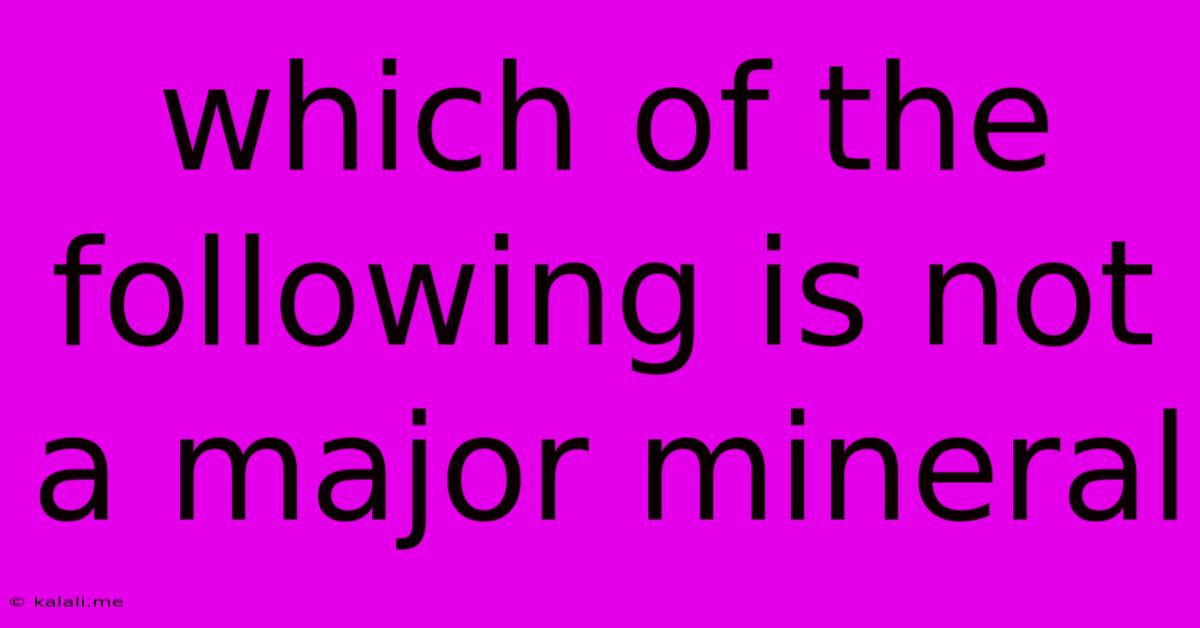Which Of The Following Is Not A Major Mineral
Kalali
Jun 14, 2025 · 3 min read

Table of Contents
Which of the following is NOT a major mineral? Understanding Essential Nutrients
This article will clarify the distinction between major and trace minerals, answering the question: which of the following is not a major mineral? We'll explore the roles of major minerals in the body and provide a comprehensive overview of essential nutrient classifications. Understanding this crucial difference is vital for maintaining a balanced and healthy diet.
What are Major Minerals?
Major minerals, also known as macrominerals, are essential nutrients required in relatively large quantities by the body. These minerals are vital for numerous bodily functions, including building and maintaining strong bones, regulating fluid balance, transmitting nerve impulses, and contracting muscles. We need them in amounts greater than 100 milligrams per day. Examples of major minerals include:
- Calcium (Ca): Crucial for strong bones and teeth, muscle contraction, nerve impulse transmission, and blood clotting.
- Phosphorus (P): Works with calcium to build and maintain bones and teeth. Also essential for energy production and DNA synthesis.
- Magnesium (Mg): Important for muscle and nerve function, blood sugar control, and blood pressure regulation.
- Sodium (Na): Regulates fluid balance, nerve impulse transmission, and muscle contraction. Plays a crucial role in maintaining blood pressure.
- Potassium (K): Essential for maintaining fluid balance, nerve impulse transmission, and muscle contraction. Works in conjunction with sodium.
- Chloride (Cl): Helps maintain fluid balance and aids in digestion. A component of stomach acid.
- Sulfur (S): A component of several proteins and amino acids. Important for detoxification processes in the liver.
What are Trace Minerals?
Trace minerals, or microminerals, are essential nutrients needed in much smaller quantities – less than 100 milligrams per day. Despite their lower required intake, they're equally important for various metabolic processes. Examples of trace minerals include:
- Iron (Fe): Crucial for carrying oxygen throughout the body.
- Zinc (Zn): Supports immune function, wound healing, and cell growth.
- Iodine (I): Essential for thyroid hormone production, regulating metabolism.
- Selenium (Se): Acts as an antioxidant, protecting cells from damage.
- Copper (Cu): Important for iron metabolism and nerve function.
- Manganese (Mn): Involved in bone formation, wound healing, and metabolism.
- Chromium (Cr): Helps regulate blood sugar levels.
- Molybdenum (Mo): Essential for enzyme function.
Identifying the Non-Major Mineral
To determine which mineral from a given list is not a major mineral, you need to compare it to the list of major minerals provided above. Any mineral not included in that list would be classified as a trace mineral. For instance, if a list includes iron, zinc, and calcium, the answer would be iron and zinc because they are trace minerals. Calcium is a major mineral.
The Importance of a Balanced Diet
Both major and trace minerals are essential for optimal health. A balanced diet, rich in a variety of fruits, vegetables, whole grains, and lean protein, will typically provide adequate amounts of these nutrients. However, individual needs may vary depending on factors like age, sex, activity level, and overall health. In cases of deficiency, supplementation may be necessary, but it's always recommended to consult with a healthcare professional or registered dietitian before starting any supplement regimen. They can help determine your specific needs and guide you toward safe and effective options.
Latest Posts
Latest Posts
-
What Is Difference Between Square And Rhombus
Jun 15, 2025
-
What Is The Lcm Of 16 And 36
Jun 15, 2025
-
For The Optical Fiber Shown In The Figure
Jun 15, 2025
-
What Organisms Can Make Their Own Food
Jun 15, 2025
-
Electric Field Inside A Non Conducting Sphere
Jun 15, 2025
Related Post
Thank you for visiting our website which covers about Which Of The Following Is Not A Major Mineral . We hope the information provided has been useful to you. Feel free to contact us if you have any questions or need further assistance. See you next time and don't miss to bookmark.